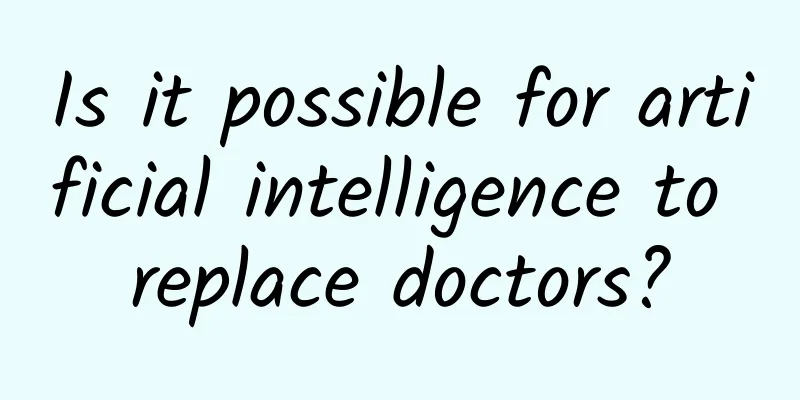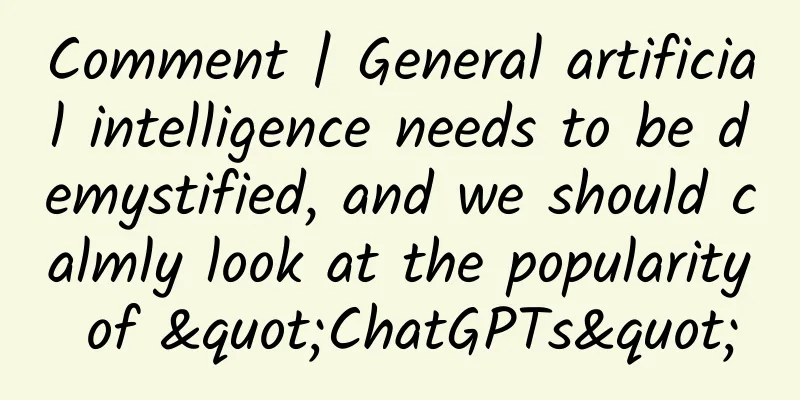Is it possible for artificial intelligence to replace doctors?

|
With the rapid development of science and technology, artificial intelligence is also making progress in the medical field with each passing day, and has achieved very impressive results, such as clinical diagnostic data analysis, telemedicine, etc. Therefore, many netizens have raised the question "Will artificial intelligence replace doctors in the future?" Personally, I think it is too early to say that artificial intelligence will completely replace doctors, but it can reduce the pressure on doctors and allow them to devote more energy to direct diagnosis and treatment. For example, medical imaging. This field can greatly reduce human errors. Why do I say that? Let's talk about it below. 01. A medical revolution brought about by scientific and technological progress Medical imaging is a typical medical advancement brought about by technology, and it can even be said to be a medical revolution. We can also judge diseases on the surface of the body, such as skin diseases. However, many diseases are internal, such as the heart, liver, spleen, lungs, kidneys or brain. In this case, how can we understand the patient's internal condition? In fact, most of the time, we can only rely on: guessing. Possible diseases are inferred through very indirect means, such as observation, auscultation, questioning and palpation, or various possible manifestations. Therefore, most of the time, this kind of speculation is actually very dependent on experience, and it also gives rise to a kind of perception that doctors are older and more reliable. But with medical imaging, everything is different. We've learned a whole new lesson about medicine since German physicist Wilhelm Röntgen first took an X-ray of his wife's left hand in 1895. For the first time, we can observe and judge the patient's body from outside the body, which was unimaginable in the past. We can only judge the patient's internal condition by observing the patient's body as a whole and touching the patient. We have no idea what is going on inside the body. For example, we cannot observe the internal condition of the bones with our naked eyes, and the same is true for the lesions of the internal organs. It can be said that for quite a long time, we were like a blind man touching an elephant. The emergence of imaging has directly promoted the progress of medicine as a whole. With the help of some media, such as X-rays, electromagnetic fields, ultrasound, etc., we can observe the internal tissues and organs of the human body on a non-traumatic or minimally invasive basis, and then the diagnostician makes a judgment based on the imaging information. It can be said that medical imaging has become the basic diagnostic strategy of many hospitals today. Whenever there is a disease that cannot be directly observed and judged with the naked eye, doctors basically require an image to be taken. 02. Constraints of Imaging - People Although imaging has developed to the point where it has become a medical necessity, this technological advancement still has one biggest problem: how to judge? The judgment of medical images still relies on manual labor. So we are back to the beginning, which is a bit like a horse-drawn train. Regardless of the type of image, the result depends on human judgment, so experience becomes an important issue. However, this also gave rise to several serious practical problems: 1. The judgment of medical images is highly dependent on rigorous training and the doctor's own experience. 2. The judgment of medical images is very time-consuming and labor-intensive, especially some subtle lesions always challenge the limits of the human eye. 3. Artificial instability. A person's daily state and occasional negligence may cause misjudgment of the image and may even lead to more problems. Despite all these years, medical imaging has developed very well, has a very strict set of standards, and has become a discipline. It can be said to be the earliest and most critical step for many diseases. Only after the basic confirmation can the next step of diagnosis and treatment be carried out. However, this problem cannot be avoided. According to statistics, a doctor who has undergone rigorous training and has rich clinical experience needs to review more than 200 CT scan images when diagnosing a case, and the diagnosis time is about more than 20 minutes. This high-intensity diagnostic work not only seriously consumes the doctor's energy, but also has a serious impact on the timeliness and accuracy of the diagnosis. Once the judgment is wrong, it may cause many serious problems. So, is there really no solution? 03. Artificial intelligence, connecting machines to machines The emergence of artificial intelligence has given us a new way of thinking. In artificial intelligence, the most notable application is image recognition. Especially with the development of machine learning, great progress has been made in recognizing images through machine learning. Medical imaging is basically based on images as core data, and this is exactly the strength of artificial intelligence. Since medical imaging is highly dependent on standard training and experience accumulation, and there are corresponding standards, machine learning can completely replace this process. Give the machine the corresponding tutorial, input the corresponding standards, and then give it enough training, then AI can become a master of imaging diagnosis. Not only can it greatly save time, but also due to the strict analysis of the machine itself, it can avoid misdiagnosis caused by careless human observation to the greatest extent. In fact, there are already related studies. By sending a large amount of images accumulated by the hospital to the server for deep learning, and then combining it with existing judgment methods for training, the machine can finally become a master of judging imaging. This greatly shortens the diagnosis time and improves the accuracy of diagnosis. Moreover, according to the ability of machine learning, the longer the time and the larger the amount of data, the smarter the system will become. In some controlled trials, its accuracy rate can be stabilized at over 85%. It should be noted that the accuracy rate of experienced doctors in tertiary ultrasound departments in corresponding tests is only 65%-70%. Moreover, one of the biggest advantages of machine learning is that machines do not get tired. It is difficult for ordinary people to concentrate on processing some content for a long time, so reading films is also a heavy burden for doctors. However, machines are not afraid of getting tired, so they can naturally process results continuously. In this case, it could even speed up medical diagnosis. I believe that many people must have experienced the problem of waiting when they go to the hospital for an X-ray. A long wait, waiting in line for half a day for registration, then waiting in line for half a day for consultation, 3 minutes for diagnosis, and then ordering an X-ray. Next, waiting in line to pay, waiting in line for the X-ray, and then waiting for a long time, waiting for the X-ray to come out, and the doctor went off work... After going through several X-rays, this cycle basically accounts for more than two-thirds of the entire medical treatment time. If AI film reading can be developed well, this cycle can be greatly shortened. Although AI image reading has not yet been put into practical use, many top institutions at home and abroad have already carried out a lot of training and learning. I believe that it is only a matter of time before AI image reading is actually used in the medical field in the future. Once realized, it will greatly alleviate the pressure on doctors and further accelerate medical progress. |
>>: "Simple" unsolved mathematical mysteries
Recommend
How to build a refined user operation system for the community?
Community operation is actually user operation , ...
Baidu screen domination quick ranking detailed practical experience, keyword interception screen domination, achieve explosive drainage, even novices can get started
2021 Baidu screen domination fast ranking detaile...
What should I do if the items I purchased through WeChat Mini Program are not delivered?
Contact WeChat customer service to complain or ca...
How much does it cost to join a restaurant kitchen app in Jixi?
For entrepreneurs, although mini program developm...
Tesla's self-driving car test: It really can go "blind"
Researchers recently tested Tesla in the laborator...
Free resources that APP promotion novices must know
Free resources that app promotion novices must kno...
An inventory of the advantages of iQOO 9 over Xiaomi 12: Which Snapdragon 8 flagship is more worth buying during the New Year’s Festival?
When you go home for the Chinese New Year, you wi...
The fourth course of Qihangge video account
Course Catalog Dagang: 1. Video account recommend...
Jiang Xiaobai’s brand upgrade strategy!
In the past two years, there has been less copywr...
How to prevent the Internet of Vehicles from becoming the next victim of the rampant “ransomware”?
Since the global outbreak of ransomware in May, i...
iQIYI Android client startup optimization and analysis
1 Introduction There is an eight-second rule in t...
Analysis of process and thread scheduling in Android: nice
In computer operating systems, processes are the ...
Ancient beverages are also becoming trendy? When tea starts to become instant
With its convenience, versatility and applicabili...









